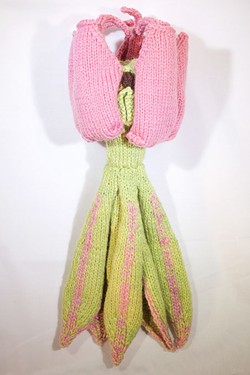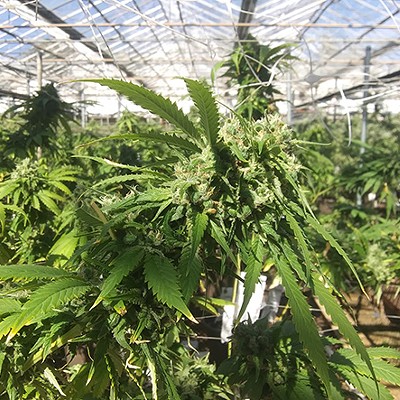When most people think about knitting, the results come down to five basic outcomes: hats, scarves, sweaters, afghans and mittens — quintessential Christmas gifts from a grandmotherly knitting needle wiz. Yet the possibilities for the form are no less than any other textile-based art, and the myriad yarn options allow for more textural variety.
Leigh Martin creates art that pulls from both her knitting acumen and her professional career as an urban forester. She intricately knits startling simulacra of plants, flowers and fungi and juxtaposes her art with natural settings. Her new installation, Missing Pieces, is on display at The Project Box, 3003 Paseo St., and she leads a Knitting Outside the Box workshop noon-3 p.m. Saturday at the gallery.
“I find that as I grow as a forester and as an artist, my fascination with ecology, organisms and natural processes flourishes as well,” Martin said on her website. “Through my artistic practice, I seek to communicate my interest in small details in the natural world. This basis of what I do speaks to the importance of connecting with nature and maintaining awareness of our surroundings, which I feel is crucial to living a fulfilling, present and creative life.”
Her “Decomposition” series concentrates on creating lifelike fungi, moss and lichen. In “Decomposition: Stacks,” Martin attaches knitted white lichen to an autumn tree, creating a perfectly beautiful illusion, while her “Decomposition: Colony” subseries assembles delicately rendered Enoki-like mushrooms to the forest floor.
Her work consistently comments on the interrelatedness of flora in the natural environment, but with Missing Pieces, an installation for which she received a Creative Projects Grant from Oklahoma Visual Arts Coalition, Martin makes a statement on how changes in nature can lead to anomalies or absences.
For example, she said, research has traced the monarch butterfly’s habitat loss to the “overwintering” of sites through deforestation and climate change. Also, milkweed plant populations, especially Asclepias genus, have been greatly reduced by roadside management and herbicides. The reductions restrict a monarch food supply.
“The effect of these missing pieces trickle down to impact the livelihood of one of the most well-known insects in North America,” she wrote.
In Missing Pieces, Martin restores knitted likenesses of milkweeds back into the environment, a simulation of the proper natural balance that also comments on how climate change, pollution, herbicidal runoff and other factors shift that balance.
In Martin’s analysis, flora carry unique responsibilities in nature, and if one piece is lost to human negligence or misadventure, a disastrous domino effect can result in lower monarch butterfly populations and other outcomes.
The self-proclaimed nature enthusiast said she has long been interested in natural observation. In addition, throughout her coursework and professional experience in the field of forestry, she developed a fascination with interconnectedness — the phenomenon of a niche and how it is impacted by changes in the surrounding ecosystem.
“Even the smallest shifts in an ecosystem’s makeup can influence the future of that setting, even though it may be undetectable to us,” she wrote.
Print headline: Spinning yarns, Leigh Martin juxtaposes her knitted flora with the natural environment in her new installation now on display.










